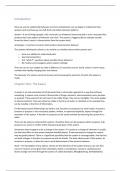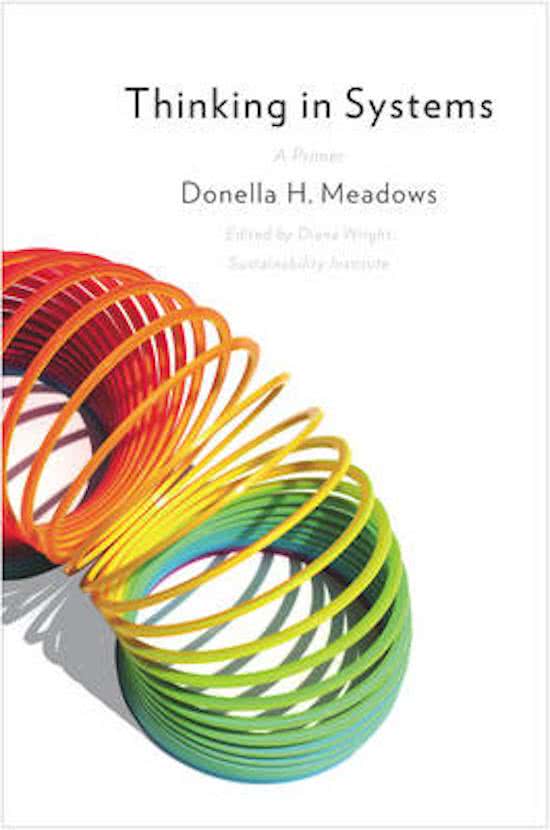Introduction
Once we see the relationship between structure and behavior, we can begin to understand how
systems work and how we can shift them into better behavior patterns.
System = A set of things (people, cells, molecules or whatever) interconnected in such a way that they
produce their own pattern of behavior over time. The system is triggered by for example outside
forces but how it reacts is characteristic from the system itself.
Archetypes = Common structures that produce characteristics behavior
The systems-thinking lens allows us to reclaim our intuition about whole systems and
o Hone our abilities to understand parts
o See interconnections
o Ask ‘’what-if’’ questions about possible future behaviors
o Be creative and courageous about system redesign
Then we can use our insights to make a difference in ourselves and our world, whom is more messy,
crowded and rapidly changing than ever before.
The behavior of a system cannot be known just by knowing the elements of which the system is
made.
Chapter One: The basics
A system is an interconnected set of elements that is coherently organized in a way that achieves
something. A system must consist of three kinds of things: elements, interconnections and a function
or purpose. These elements do not have to be visible things, they can be intangible. The same applies
to interconnections. They can either be visible in the form of water in a bathtub or for example they
can be invisible in the form of information.
If information based relationships are hard to see, functions or purposes are even harder. A system’s
function or purpose is not necessarily spoken, written, or expressed explicitly, expect through the
operation of the system. A function or purpose can be easily revealed by observing the system for a
while.
There can be systems nested within systems. Therefore there can be purposes within purposes. Sub-
purposes can come in conflict within the general purpose of the system.
Sometimes there happens to be a change in the system. If it concerns a change of elements it usually
has the least effect on the system (example football player). If interconnections change the system
may be greatly altered. There is a significant possibility that the system is unrecognizable. And last but
not least changes in function or purpose can also be drastic. The least obvious part of the system, its
function or purpose, is often the most crucial determinant of the system’s behavior.
Stock = The foundation of any system. Stocks are the elements of the system that you can see, feel,
count or measure at any given time. (Examples: books in a bookstore, money in a bankaccount)
Stocks change over time through the actions of a flow (Examples: filling&draining, births&deaths).
, Dynamic equilibrium = The stock does not change but the flow is continuously flowing. (static
equilibrium = when there is no flow)
There are several important principles that extend to more complicates systems:
o As long as the sum of all inflows exceeds the sum of all outflows, the level of the stock will
rise.
o As long as the sum of all outflows exceeds the sum of all inflows, the level of the stock will
fall.
o If the sum of all the ouflows equals the sum of all inflows, the stock level will not change →
Dynamic equilibrium.
A stock can be increased by decreasing its outflow rate as well as increasing its inflow rate. Therefore
it is important to keep in mind that flow takes time to flow, as a result from that a stock takes time to
change. The last important principle regards to stocks and flow is that stocks allow inflows and
outflows to be decoupled and to be independent. System thinkers see the world as a collection of
stocks along with the mechanism for regulating the levels in the stock by manipulating flows.
Feedback loop = is formed when changes in a stock affect the flows into or out of that same stock.
Not all systems have feedback loops.
Balancing feedback loop (stabilizing loop) = Equilibrating or goal-seeking structures in systems and
sources of stability and sources of resistance to change.
Reinforcing feedback loop (runaway loop) = This feedback loop is reinforcing, snowballing. A circle
that can cause healthy growth or runaway destruction.
When a stock has the capacity to reinforce or reproduce itself the growth is exponential. Equal
growth is called linear growth.
Chapter Two: A brief visit to the systems zoo
One stock systems – Loops trying to drag a single stock to two different goals. For example a
thermostat system.
One stock systems
A stock with two competing balancing loops
An important general principle in this situation is that the information delivered by a feedback loop
can only affect future behavior. That means there will always be delays in responding. That means a
flow can only react to a
change in a stock and not
directly in a flow.
Every balancing feedback
loop has it’s breakdown
point, where other loops pull
the stock away from its goal






